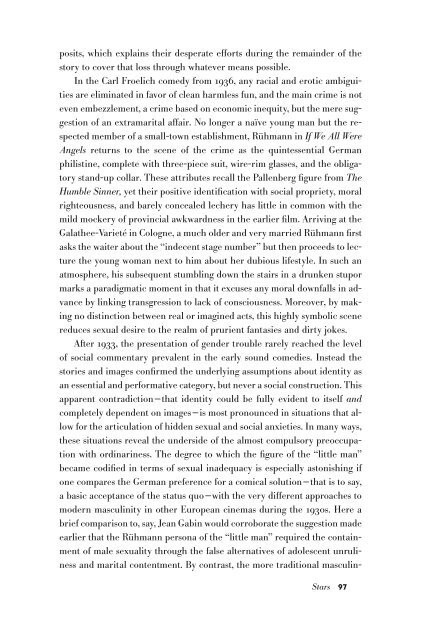You also want an ePaper? Increase the reach of your titles
YUMPU automatically turns print PDFs into web optimized ePapers that Google loves.
posits, which explains their desperate efforts during the remainder of the<br />
story to cover that loss through whatever means possible.<br />
In the Carl Froelich comedy from 1936, any racial and erotic ambiguities<br />
are eliminated in favor of clean harmless fun, and the main crime is not<br />
even embezzlement, a crime based on economic inequity, but the mere suggestion<br />
of an extramarital affair. No longer a naïve young man but the respected<br />
member of a small-town establishment, Rühmann in If We All Were<br />
Angels returns to the scene of the crime as the quintessential German<br />
philistine, complete with three-piece suit, wire-rim glasses, and the obligatory<br />
stand-up collar. These attributes recall the Pallenberg figure from The<br />
Humble Sinner, yet their positive identification with social propriety, moral<br />
righteousness, and barely concealed lechery has little in common with the<br />
mild mockery of provincial awkwardness in the earlier film. Arriving at the<br />
Galathee-Varieté in Cologne, a much older and very married Rühmann first<br />
asks the waiter about the “indecent stage number” but then proceeds to lecture<br />
the young woman next to him about her dubious lifestyle. In such an<br />
atmosphere, his subsequent stumbling down the stairs in a drunken stupor<br />
marks a paradigmatic moment in that it excuses any moral downfalls in advance<br />
by linking transgression to lack of consciousness. Moreover, by making<br />
no distinction between real or imagined acts, this highly symbolic scene<br />
reduces sexual desire to the realm of prurient fantasies and dirty jokes.<br />
After 1933, the presentation of gender trouble rarely reached the level<br />
of social commentary prevalent in the early sound comedies. Instead the<br />
stories and images confirmed the underlying assumptions about identity as<br />
an essential and performative category, but never a social construction. This<br />
apparent contradiction—that identity could be fully evident to itself and<br />
completely dependent on images—is most pronounced in situations that allow<br />
for the articulation of hidden sexual and social anxieties. In many ways,<br />
these situations reveal the underside of the almost compulsory preoccupation<br />
with ordinariness. The degree to which the figure of the “little man”<br />
became codified in terms of sexual inadequacy is especially astonishing if<br />
one compares the German preference for a comical solution—that is to say,<br />
a basic acceptance of the status quo—with the very different approaches to<br />
modern masculinity in other European cinemas during the 1930s. Here a<br />
brief comparison to, say, Jean Gabin would corroborate the suggestion made<br />
earlier that the Rühmann persona of the “little man” required the containment<br />
of male sexuality through the false alternatives of adolescent unruliness<br />
and marital contentment. By contrast, the more traditional masculin-<br />
Stars 97

















